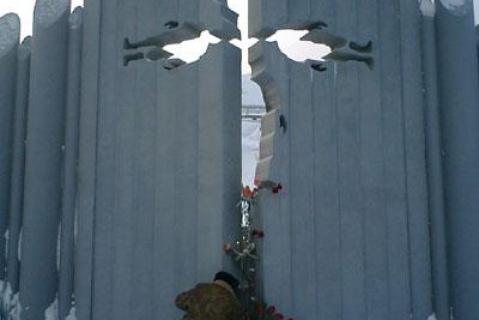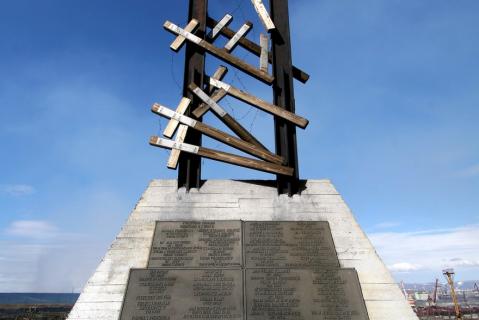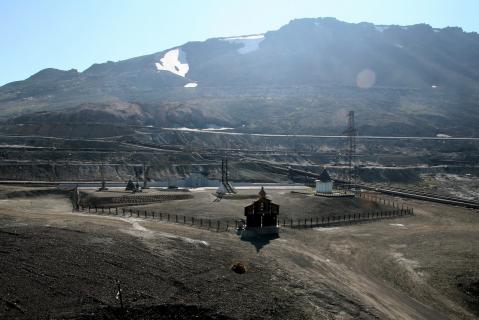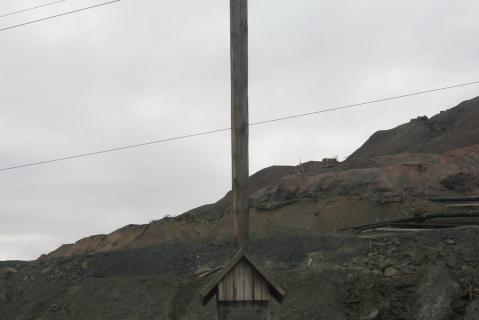The memorial cemetery of the “Norilsk Golgotha” is part of the former burial ground of Norillag where prisoners bodies were interred between 1935 and 1956. The numbers buried there are unknown; there are no lists of names.
After 1953 it became the town cemetery. Closed in 1987, some of the burials were transferred by relatives to the new cemetery. The remaining graves, headboards and railings were destroyed and exposed remains were carted away. Much of the territory was used for industrial construction.
In 1989, thanks to the efforts of the Norilsk Memorial Society and the Norilsk Industrial Museum, the human remains in the destroyed cemetery were gathered together and in 1990 they were reburied in a common grave crowned with a wooden cross. It was then, at the suggestion of the Norilsk Industrial Museum and the Norilsk Memorial Society, that the town administration decided to create the “Norilsk Golgotha” memorial complex on the remaining territory of the cemetery. The memorial was created, thanks to the efforts of enthusiasts in Norilsk, the Baltic States and Poland with the support of the city administration, the Norilsk Nickel mining company and the public organisation “For the Defence of Victims of Political Repression”.
At the entrance to the complex stands a wooden bell tower (2001). Nearby is a granite pillar (2004) with the inscription: “Here at Mount Schmidt is Norilsk’s first cemetery. Tens of thousands of Norillag prisoners, from the USSR and other countries, who died or were executed were buried here between 1935 and 1956”. Within the memorial area there is an Orthodox chapel dedicated to the Pure and Life-giving Cross of our Lord (1990), a variety of personal memorials to prisoners from the Baltic States (1991), a memorial to the Polish prisoners of Norillag (1996, rebuilt in 2001), a monument to the camp’s Jewish prisoners (2005) and a memorial “The last gates” (2005).
A Book in Remembrance of the Victims of Political Repression in the Krasnoyarsk Krai (13 vols. 2004-2014) includes biographical entries for 45,400 who were shot or sent to the camps.
The Memorial online database (2025) includes 55,742 victims in the Krasnoyarsk Krai (Region). See Yeniseisk.
30,000 were sent to camps or special settlements elsewhere. Drawing on other sources, however, the database lists more than 12,000 sent to the the Krasnoyarsk Region, some to its camps (1,017), most to its special settlements (11,000).
| Date | Nature of ceremonies | Organiser or responsible person | Participants | Frequency |
|---|---|---|---|---|
|
3rd Sunday in July
|
Laying of wreaths on Day of the Metallurgist
|
Norilsk city administration
|
City administration, Norilsk Nickel, public
|
Annual event
|
|
30 October
|
Remembrance Day for the Victims of Political Repression
|
History of Norilsk Museum and educational institutions of Greater Norilsk
|
City administration, Norilsk Nickel, former political prisoners, descendants of those arrested and shot, schoolchildren, members of the "Defence of Victims of Political Repression" association, city inhabitants
|
Annual event
|
|
Commemorative Services
|
From time to time
|
| State of burials | Area | Boundaries |
|---|---|---|
|
Original headboards have not survived; the site of reburial is in good condition
|
Extent of the historic graveyard not determined; memorial section covers 0.5 hectares
|
Historic boundaries not established; a fence surrounds the memorial area
|
[ original texts and hyperlinks ]
“The Norilsk Golgotha memorial complex by Mount Schmidt” The History of Norilsk in Memorials and Streets website
“The Norilsk Golgotha memorial complex”, website of the Norilsk and Turukhansk Diocese [retrieved, 17 January 2025]
“The Norilsk Golgotha memorial complex”, The Virtual Museum of the Gulag [retrieved, 30 May 2022; no longer accessible]
*
Reply from the Norilsk City Administration (№ 012-2981 of 2 July 2014) to a formal enquiry by RIC Memorial (St Petersburg)




